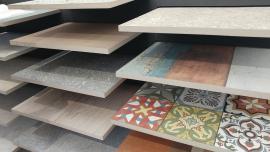World production and consumption of ceramic tiles (2023)
ACIMAC research Dept/MECS anticipates to Ceramic World Review the key figures of the 12th edition of the annual report “World production and consumption of ceramic tiles”. In 2023 world tile production and consumption fell by 5.5% and 5% respectively. World tile import-export flows also saw a decrease, down 2.3% on 2022.
The twelfth edition of the study “World production and consumption of ceramic tiles” produced by MECS Acimac Research Centre is due to be published in October. Consisting of almost 300 pages of charts, tables and commentary, the study provides detailed analysis of the trends occurring over the ten-year period to 2023 in terms of industry, markets, per capita consumption and export flows in geographical macro-regions and in the 76 largest tile producer, consumer, exporter and importer countries.
It includes an in-depth analysis of the breakdown of import and export volumes for each individual country by product type (porcelain stoneware, single and double-fired tiles, other materials).
Once again this year, the study will be accompanied by the publication of the volume entitled “Ceramic Tile Market Forecast Analysis 2024-2028”, which provides an updated five-year forecast for the global ceramic tile market. (For info: info@mecs.org)
Global tile production fell below 16 billion sqm
Overall, the global ceramic industry and market continued to experience a downturn in 2023, following the negative trends observed in 2022. The continuation of the general economic slowdown marked by high inflation and high interest rates led to a further cooling of global tile demand. This in turn resulted in a continued contraction in global production and import-export volumes, although the declines were less severe than those experienced in 2022.
Global tile production decreased by 5.5% in 2023, falling to 15,937 million sqm from 16,862 million sqm in 2022. This reduction of approximately 900 million sqm was spread across all continents except for Africa.
Production in Asia fell by 5% from 12.2 to 11.6 billion sqm, equivalent to 73% of global output. China and Vietnam contributed losses of 580 million sqm and 180 million sqm respectively to this decline.
The European continent produced a total of 1,654 million sqm (10.4% of world production). The biggest contraction was in the European Union (down 18% from 1,267 million to 1,039 million sqm), with Italy and Spain both dropping below an output of 400 million sqm. Non-EU Europe held up better (615 million sqm; -4.2%), but was negatively affected by the contractions in Turkey and Russia.
Production in the American continent also fell, dropping to 1,473 million sqm. North America saw a decline in output from 378 to 349 million sqm (-7.7%), while production in Central and South America fell to 1,124 million sqm, a decrease of-10.3%.
As mentioned, Africa bucked the global trend with a further increase in production in 2023 to 1,178 million sqm (+9.9%), thanks to increases in Egypt (400 million sqm), Algeria (185 million sqm), Ghana (120 million sqm) and Nigeria (125 million sqm).
The international trade decreased to 2.75 billion sqm
In 2023, global exports continued the downward trend that began in the previous year, although the decline eased slightly, registering a drop of 2.3% compared to a 7% decrease in 2022. Total world exports amounted to 2,753 million sqm, 66 million sqm less than the previous year. The contraction affected all geographical areas with the sole exception of Asia, whose exports grew by 15% from 1,354 million to 1,557 million sqm, thanks to the recovery of China (+6.2%) and the continued surge in Indian exports (+39.6%).
This contrasts with a double-digit contraction in exports from the European Union (from 965 million to 772 million sqm; -20%), non-EU Europe (from 174 million to 132 million sqm; -24.4%) and from Central and South America (from 167 million to 138 million sqm; -17.4%). North America saw a smaller decline in exports (from 48 million to 43 million sqm; -9%), while exports from African countries remained stable at 111 million sqm.
Read the complete article published in Ceramic World Review no 158
Did you find this article useful?
Join the CWW community to receive the most important news from the global ceramic industry every two weeks
























